Why “Three” is Important in Mesoamerica and in the Book of Mormon
by
Diane E. Wirth
© 2012
Numbers are mentioned numerous times in the Book of Mormon and in the Bible. John Welch said regarding numbers in scripture, “The number of times something occurs or is mentioned . . . may or may not be intrinsically significant, but the fact that ancient prophets and inspired writers made a point of mentioning these numbers invites gospel students to stop and wonder why.” Then he suggests these numbers may have “some latent meaning."1 This, of course, would follow through with the use of numbers in the Book of Mormon and in traditions of Mesoamerica. This paper will be discussing the number three.
Bullinger’s book, Number in Scripture, is very informative on the use of the number three. For example, he notes that three lines are necessary to form a plane figure, that is, the triangle. There are three divisions in time―past, present, and future. There are three things in matter on this earth―animal, vegetable and mineral. And most important, the number three gives us the connotation of what is real, essential, perfect, complete, and the Divine2
In the Book of Mormon the word “three” may refer to a number of people or generations, or it could refer to lengths of time. For example, for three days Lamoni laid in his bed as if dead,3 or a distance could be referred to as taking three days to arrive at a destination. The more significant scriptures using “three” in the Book of Mormon refer to the requirement of three witnesses,4 the three days between Christ’s crucifixion and resurrection,5 and the three disciples who were granted their wish of serving the Lord while not tasting death until Christ’s return.6
We have all heard the expression, “If at first you don’t succeed, try, try again.” This phrase may mean doing something at least three times, and that is exactly what Nephi needed to do to fulfill the Lord’s and his father’s command to obtain the Brass Plates that were in the possession of Laban. The third time he tried he succeeded, but it wasn’t until the spirit constrained Nephi three times to kill Laban.
In reading the Book of Mormon we find that there are several occurrences where the number of three hours or three times a message is spoken from the powers above. For example, the Lord talked for three hours to the brother of Jared.7 Helaman chapter 5 records an event about 30 B.C., when the Nephites named Nephi and Lehi were cast into a prison. A voice from heaven came three times crying repentance to the Lamanites, the earth trembled, and many of the people were convinced of the power of God and repented.
In 3 Nephi we read that after three days of darkness a voice came from the heavens three times before Christ visually appeared, followed by his visitation for three days. On other occasions a message was given three times to a prophet, not to mention this is the number of times Joseph Smith was visited by Moroni—three times in one night.
Perhaps the most significant scriptures in the Book of Mormon having to do with a grouping of three are those with reference to the Godhead: God the Father, God the Son, and the Holy Ghost or the Holy Spirit.8 The Godhead is the backbone of the Book of Mormon.
When one studies Mesoamerica they recognize that three of this and three of that was extremely important. There was a triad of three supreme gods at many sites; there were also triads of buildings built during the pre-Classic period which coincides with the Book of Mormon era; and there was the pan-Mesoamerican mythology of the Three Stones of Creation. Is there a connection between the use of “three” for the Book of Mormon writers who lived in Mesoamerica, and the use of threesomes prevalent among the ancient cultures of Mesoamerica?
An example of the number three in Mesoamerica is the sacred planting ritual that was and still is performed by the Mixe of Oaxaca, Mexico. In Frank Lipp’s investigation of the Mixe, he noticed that there is a three-day period of sexual abstinence in preparation for a ritual and prayer to their three lightning gods. It may be significant that three days of sexual abstinence was also known from David’s time as recorded in 1 Samuel 21:4-6. In the Mixe ritual, three lit cigarettes are placed in the ground as an offering to three gods and three shots of mescal are poured on the ground. A cup of mescal is passed around three times for each participant. Again, referring to a Jewish custom, it is the third cup of wine that Jews call upon Elijah to return at Passover and fill his glass.9 The Mixe ritual is followed by a turkey held aloft in three directions.10
Today, this ritual is culminated by a prayer to the Christian God for abundance of crops and well-being for their people. This is how many cultures still worship in Mexico and Central America, mixing their old ways with the newer religion of Christianity. Archaeologists don’t know why the number “three” is so significant for the Mixe rituals and offerings. We can only surmise that there is a plausible reason that has been lost. Combinations of three as used in Mesoamerica will now be discussed.
The Popol Vuh of the Quiché Maya speaks of three creator gods, and many Mesoamerican sites had a triad of gods. Each polity had a different set of names for their three deities. Some speculate that is why Christianity was accepted so readily by the natives. After the Spanish Conquest, a Spanish priest by the name of Francisco Hernandez studied the natives and concluded the Indians already believed in the Trinity. He sent a letter to Bartolome de las Casas, a Bishop of Chiapas in the mid 1500’s, and las Casas reported what Hernandez wrote:
|
|
They knew and believed in God who was in heaven; that that God was the Father, the Son and the Holy Ghost. That the Father is called by them Icona [Içona in the Spanish text] and that he had created man and all things. The Son’s name was Bakab who was born from a maiden who had ever remained a virgin, whose name was Chibirias, and who is in heaven with God. The Holy Ghost they called Echuac.11
|
By the sixteenth century the names became somewhat altered. The little comma-like hanging from the “ç” gives us a pronunciation in Mayan of “ts,” so this name would be pronouced Itzona. This is obviously a transliteration of the name of Itzamna, for which Professor Karen Bassie-Sweet would agree.12 Mayanists acknowledge that Itzamna was the supreme god of the Maya. He was the father of the Maize God, and Bakab, as used in the above paragraph, is most likely one of the manifestations of the Maize God according to some scholars.13 Nevertheless, we have to be extremely careful in saying that these three gods represent the Father, Son and the Holy Ghost. The high god, Itzamna, is clear. Bakab as the Son takes a stretch, but very plausible. Echuac was the god of merchants, and merchant travelers prayed to him for their safety. One might say this god gave guidance and protection and that is part of the role of the Holy Ghost. Itzamna, Bakab, and Echuac were three separate gods, not three gods of one essence as is the case with the Catholic tradition of the Trinity.

An example of the substitution that was used by the Maya when they were converted to Christianity is in order. The central altarpiece of the Catholic Church in Santiago Atitlan, Guatemala, has the typical symbols on its corners of the four evangelists: Matthew, Mark, Luke and John. Instead of an eagle for John on the upper right-hand, the sculptor carved a quetzal bird, and the usual bull for Luke is a deer (see Figure 1). At the altar’s center is the Maize God in lieu of Christ.14
This illustration is by Allen Christenson. The Maize God was also placed on the priest’s chair, where ordinarily there would have been a lamb or cross―something that pertained to Christ.
The Maize God was a dying and resurrecting god, and since Christ was also known as “the bread of life,” the cultures of the New World didn’t have any trouble associating the Maize God with Christ. For those interested, my article in the Journal of Book of Mormon Studies, entitled: “Quetzalcoatl, the Maya Maize God, and Jesus Christ,” may be viewed on the Internet.15
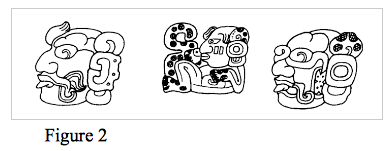
The triadic pantheon of gods at Palenque, in particular, is possibly part of a very ancient and indigenous Maya tradition (see Figure 2). GI is the first head of what scholars call the Palenque Triad: GI, GII, and GIII, in other words, God I, God II, and God III. They were called in Mayan, huntan, which roughly means “precious beings.”16 GI is the most important of this trio. He was born on 9 Ik’, which means 9 Wind, and GI may be considered similar to Quetzalcoatl in his guise as Ehecatl-Quetzalcoatl who was also born on 9 Wind.17 What else do Quetzalcoatl and GI have in common besides their birth dates? They were both related to Venus and to the Sun; they both took their authority from the supreme creator, in fact, they were both the first son of the Creator; they both had aspects of the dying and resurrecting Maize God; they both wore shells, especially as a pectoral or earflares; and they were both involved in the creation.18
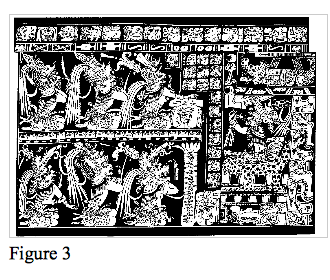
GI is portrayed on what Mayanists call the Vase of the Seven Gods from Naranjo, Guatemala (see Figure 3). This deity has been identified as the middle figure in the lower register on the Vase of the Seven Gods. GI had a role in the council of gods before the world was created.19 His Mexican counterpart Ehecatl-Quetzalcoatl, like GI, also performed a significant act that created the heavens and the earth. The black background of this vase denotes that the scene takes place in primordial times, and the text signifies that these gods ordered and set in place the universe on the day of Creation.20
In the Popol Vuh, the Feathered Serpent was in council with the gods before the creation. Archaeologists who study Mesoamerica acknowledge that the Maya believed the gods held council before the creation, and of course, so does the Book of Abraham. An excerpt from Doctrine & Covenants 121:32 reads, “That which was ordained in the midst of the Council of the Eternal God of all other gods before the world was . . .” And in Shepherd of Hermas, which writing was considered scripture by Christians in the 2nd century, reads: “The Son of God is indeed more ancient than any creature; insomuch that he was in council with his Father at the creation of all things.”21
GI also has another important association, and that is with the World Tree, Tree of Life, or Cosmic Tree, whichever one prefers to call this shiny, resplendently-jeweled tree. Centered at the axis mundi of the cosmos, it was as bright as the sun and therefore associated with GI, according to Mayanist David Stuart. This Tree also has a strong connection to resurrection, and so does GI―again according to Stuart.22 Stuart’s findings are referred to here because he is one of the foremost scholars in the world of the Maya. Stuart notes that GI was crowned in the heavens by the creator god, Itzamna, before the world began. Itzamna is of course the most supreme of all Maya gods. GI also descended from the sky to the earth to his temple.23 All three of the gods in the Palenque Triad are what Karen Bassie-Sweet believes to be manifestations or aspects of the Maize God,24 the dying and resurrecting god.
Latter-day Saints cannot expect everything they understand about the Godhead, or even what they knew in Book of Mormon times, to follow through and be transferred to an apostate culture. Scholars have gained much insight and knowledge of Mesoamerican religions in the past thirty years. The Lamantes and any other indigenous groups in Mesoamerica had their own religion, but even when some aspects were borrowed, say from the Nephites, it was most likely altered from what the Nephite prophets taught; yet one can see remnants of truth. These are what I call “golden threads,” and Golden Threads will be part of the title for my next book.25
The second deity in the Palenque triad of gods is GII, who was a symbol of royal power, re-birth, and regeneration.26 As for GIII, Mayanists are not in agreement of this god’s role, but this deity has to do with the sun of the underworld, that is the sun as it descends in the west and cannot be seen—that is when the Maya believed the sun passes through the underworld. The Maya weren’t restricted to give specific interpretations as we require today. We need the details―but, it just didn’t work that way in ancient cultures. The Maya held many overlapping symbols and meanings in their traditions, especially when it came to their gods.27 That is why the many descriptions one reads by scholars are often confusing and appear contradictory, but for the cultures of ancient Mesoamerica, symbolism was interwoven with many different colored threads and made perfect sense.
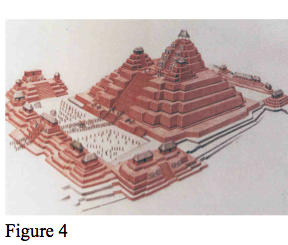
The second point we are going to consider with a grouping of three is in the pre-Classic architecture of Mesoamerica. Starting with the grand city of El Mirador in Guatemala, it was the largest city built in pre-Classic times beginning in approximately the 6th century B.C. A triadic pattern was the most frequent arrangement of buildings at this site. Consisting of approximately 35 triadic structures, El Mirador had platforms topped with a set of three pyramids. For example, the Tigre pyramid has a triad of temples on its summit (see Figure 4).

Teotihuacan in the Valley of Mexico, which commenced in 100 B.C. is another place with many triadic formations of buildings―there were over 20 groupings of three structures at Teotihuacan (see Figure 5).
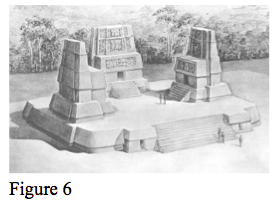
Uaxactun is another early site with triadic structures (see Figure 6). Other pre-Classic sites such as Cerros, Nakbe, Lamanai and the North Acropolis at Tikal, also have triadic groupings in their architecture. Sometimes the triadic motif appears as doorways as at Yaxchilan (see Figure 7), or three segments with three roof combs as is the case at Labna in the Yucatan. Triadic arrangements in pre-Classic times suggest a deep rooted symbolism behind the number three.
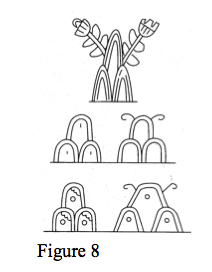
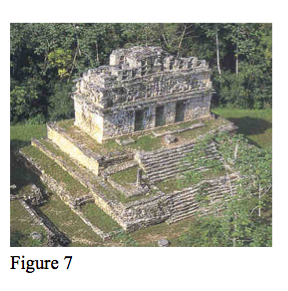
Also, the grouping of three mountains or mountain ranges as at Teotihuacan, were important to Mesoamerican cultures. This is how mountains appear in the codices (see Figure 8). This is especially true around beautiful Lake Atitlan, Guatemala, where there are three volcanoes that ring the lake. When there are three mountains in view like Lake Atitlan, the natives believed this was the axis mundi, the center of the world, the place where creation began.
For the next grouping of three, we need to look up at the night sky to see the constellation Orion, a grouping of stars that was very special among the Maya. The Maya held that the Maize God was sacrificed, died, and went to the heavens where he was resurrected from a turtle—purely symbolic, of course. The turtle represents the earth, but it also has a counterpart in the sky―the constellation of Orion. In a Maya mythological perspective, the constellation Orion was seen as a turtle (see Figure 9)..png)
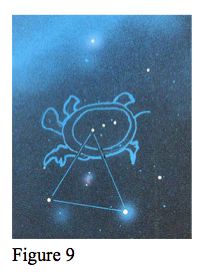
This turtle encloses a full motif of a star―it’s a Maya logogram for a star (see Figure 10). From Bonampak in Chiapas, Mexico, we have the famous Bonampak murals. The turtle and the three stars of Orion are at the top of one of the murals. In the Maya Madrid Codex, there are the three stones on the turtle’s back, hanging from a sky band.
Notice the three stars in Orion (see Figure 9) that represent what the Maya called the “Three Stones of Creation.” The Orion Nebula is contained within a triangle of stars . From the left star of Orion’s belt, Alnitak, and going down to the left to Saiph and then to Rigel on the right, the triangle is formed containing the Orion Nebula. These three stars are considered metaphorically stones by the Maya. They are the “Three Stones of Creation.”
There is an interesting connection of the dying and resurrecting Maya Maize God and his association with the constellation of Orion. The dying and resurrecting Egyptian grain god, Osiris, is also associated with Orion. Both Osiris and the Maya Maize God were ferried in a celestial boat down the river in the sky, the Milky Way, to Orion where both were resurrected.

The Egyptian Grain God Osiris was called Sahu when associated with Orion. He is not only in his boat, but the three stars of Orion appear over his head (see Figure 11). Going back to the Americas, the Star Kachina (see Figure 12) of the Hopi is called Sohu (or Soohu).28 Again, the Egyptian god Osiris is called Sahu in his celestial sky form. There are three stars on this kachina Sohu’s headdress, which brings to mind the most important constellation in Hopi cosmology, Orion, and Orion has three stars at its center called the belt of Orion.
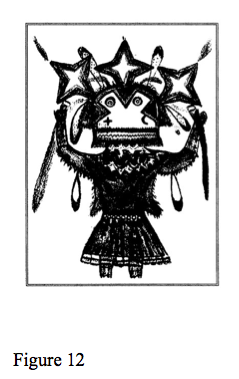
Archaeologists know the Hopi had contact with Mesoamerica. The Hopi even had a Parrot Clan. There were no parrots of the macaw variety, native to the desert. Macaws could only survive in the wild of the Maya humid lands of Mesoamerica. As for Egyptian influence or Middle Eastern traditions on Mesoamerica, as Latter-day Saints we know how they came to the New World.29
According to National Geographic the Orion Nebula is where stars are born, perhaps the creation of planetary systems like ours.30 Due to a cloudy-like, smoky haze appearance to the naked eye within this triangle of three stars in Orion, Mesoamericans mirrored this imagery with three hearthstones for their fires. They believed what is above in the heavens is mirrored below. John Tvedtnes informed me regarding this mirroring effect that: “this is a common Jewish concept as well, found in various ancient and medieval texts. It applies to the Temple and to ritual activities.”31
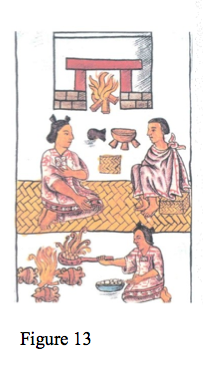
The Florentine Codex made by the Aztec shows the idea of the three hearthstones, which was a pan-Mesoamerican tradition (see Figure 13). When the Maya build a new house, they start with the hearth, and by doing so re-enact the story of the creation. Again, they wanted to replicate what was in the heavens to also be on the earth. The hearth, serving as the axis mundi, emitted fire at its center, just as the three stars in Orion encompassed a great cosmic fire in the Orion Nebula. David Freidel and Linda Schele realized that these three stones in the sky “were the analog of the three stones of the hearth and that the triadic arrangement in architecture replicated this arrangement.”32
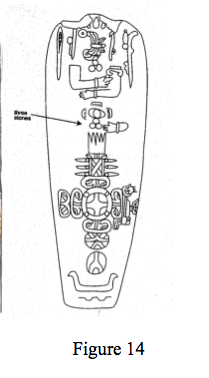 How far back in Mesoamerican mythology do the “Three Stones of Creation” exist in their creation lore? Several scholars believe the Olmec knew of the Three Stones of Creation as is evidenced in the Humboldt Celt, which was made about 500 B.C. (see Figure 14). The three stones are being cast by a hand, which would have been done by a creator god. Above it is a star eye and the three surrounding motifs are said to be clouds—so, this is an event that happened in the heavens.33
How far back in Mesoamerican mythology do the “Three Stones of Creation” exist in their creation lore? Several scholars believe the Olmec knew of the Three Stones of Creation as is evidenced in the Humboldt Celt, which was made about 500 B.C. (see Figure 14). The three stones are being cast by a hand, which would have been done by a creator god. Above it is a star eye and the three surrounding motifs are said to be clouds—so, this is an event that happened in the heavens.33
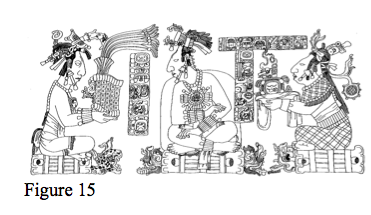
The Maya took the “Three Stones of Creation” a bit further, and their hieroglyphs say there were Three Throne Stones placed in the sky. This particular scene has rulers sitting on three thrones in Palenque (see Figure 15). When they did this, they were reenacting the creation, because these three throne stones were not only placed by deities, but they supposedly occupied these thrones at the time of the creation.The first two of these throne stones were called the Jaguar Throne Stone and the Snake Throne Stone. It was Itzamna, their supreme god of creation, who placed the last throne stone, the Water-Lily Throne Stone, as well as binding all of them together.34 The fact that these creation stones were bound together is quite significant when referring to Jewish texts that speak of the “foundation stone” of the world which was formed of several large gem-stones that were later fused together. The Foundation Stone, according to Jewish legend, served as the starting point for all that was created by God in the center of the universe.35
On Stela C at the Maya site of Quirigua, a hieroglyphic text records the event of placing the Three Throne Stones, where the bottom of the stones has the same design as Throne Stones that we saw at Palenque in Figure 15. Several archaeologists claim that one of the deities who placed a stone of creation, whether you want to call it a throne stone or a hearthstone (it signified both), was the Maize God,36 the dying and resurrecting god. It was the Paddler Gods who took the Maize God in their canoe down the Milky Way, considered a river in the sky, to this sacred spot in the cosmos in Orion. For this reason, the text says that the Paddler Gods laid the first stone. The Maize God, who is called Hunahpu in the Popol Vuh, carries a plausible Stone of Creation on his head, according to Mayanist Karl Taube.37
Robert Smith wrote an interesting article on Chiasmus, published in the Journal of Book of Mormon Studies in 2007. He takes the text on Stela C at Quirigua that contains the setting in place of these three stones, and breaks it down into its chiastic form, starting with the date of creation.
|
|
A [calendar date ― first day of creation]
B Three stones were set,
C The Paddlers erected a stone; it happened at 5 Sky House, Jaguar Throne stone,
Center The Black God erected a stone; it happened at Earth Center Place, Serpent Throne stone,
C And then it happened that Itzamna set a stone, Water-Lily Throne stone; it happened at Sky Place,
B New, three-stone place
A [calendar date] completed under the authority of 6 Sky Lord”38
|
(6 Sky Lord may be another name for GI from the Palenque Triad that was discussed earlier, who was one of the creators)39
The ABCCCBA chiastic arrangement is very clear with the C-statements as the peak event of this episode―setting the stones in place. Mayanists Nicolas Hopkins and his late wife, Kathryn Josserand, wrote: “In terms of Classic Maya literary canons, this kind of [chiastic] structure marks a text as very formal, like modern Mayan prayers, which consist entirely of couplets, often nested in this fashion.”40 The Old Testament, the Book of Mormon, and even the Maya Popol Vuh are full of chiastic prose.41
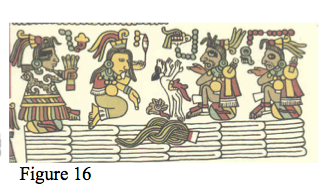 Cultures from central Mexico also had knowledge of the “Three Stones of Creation.” From the Codex Nuttall, a codex made by the Mixtec of Mexico, three supernatural gods are sitting on three stones (see Figure 16). The other significant illustration that archaeologists acknowledge is the “Three Stones of Creation” in the Seldon Codex, also made by the Mixtec. This particular one has the Tree of Life, or World Tree, and depicts the first man being born, with his umbilicus still attached to the tree. The Three Stones are placed at the bottom foundation. It all ties in with the creation theme.
Cultures from central Mexico also had knowledge of the “Three Stones of Creation.” From the Codex Nuttall, a codex made by the Mixtec of Mexico, three supernatural gods are sitting on three stones (see Figure 16). The other significant illustration that archaeologists acknowledge is the “Three Stones of Creation” in the Seldon Codex, also made by the Mixtec. This particular one has the Tree of Life, or World Tree, and depicts the first man being born, with his umbilicus still attached to the tree. The Three Stones are placed at the bottom foundation. It all ties in with the creation theme.
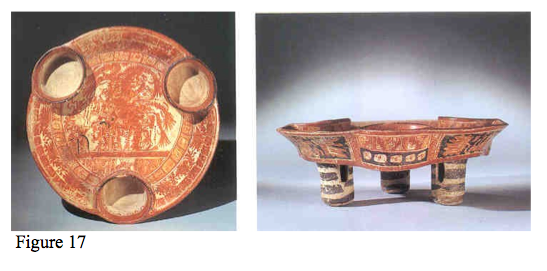
In addition to using three hearthstones in remembrance of the “Three Stones of Creation,” Mesoamericans also incorporated the idea in their three footed bowls (see Figure 17). This one not only has three legs, but three chip and dip-type containers at the top. In 1996 in Lamanai, Belize, the guard opened a little shack for me at the site, and there were many three-footed bowls on the shelves.
The placing of three objects by today’s Mexican and Central American cultures, whether they be stones for their hearth fires, cigarettes or candles, or the other three-footed items, it was done in remembrance of the Three Stones of Creation. Again, they wanted what is mirrored above in the heavens, to be mirrored below on earth, and in a way, by doing these rituals they were re-enacting the moment of creation. In other words, they brought the sacred past into the present.
Some Mayanists theorize the Three Stones of Creation represent the Palenque Triad: GI, GII, and GIII, or various deities who are three in number.43 Other scholars suggest that the Three Stones of Creation symbolize the earth, sky, and the underworld.44 This is very interesting when considering a medieval writing from the Jewish Zohar Hadash on the creation.
|
|
Blessed be the name of the King of Kings, the Holy One, blessed be He, who created the world and established it with wisdom, understanding, and knowledge [notice the three], and corresponding to them He created three worlds: the Upper world, the lower world, and the middle world.45 |
Another writing from the same Zohar Hadash, Genesis 16a-c says that God did not personally create the world, but created three artisans (the heaven, the water, and the earth), while reserving to himself the right to make the soul (personal communication from John Tvedtnes).46
What does this discussion have to do with the Book of Mormon? Reviewing Joseph Smith―History 1:52, we read:
|
|
Having removed the earth, I obtained a lever, which I got fixed under the edge of the stone, and with a little exertion raised it up. I looked in, and there indeed did I behold the plates, the Urim and Thummim, and the breastplate, as stated by the messenger. The box in which they lay was formed by laying stones together in some kind of cement. In the bottom of the box were laid two stones crossways of the box, and on these stones lay the plates and the other things with them.
|
This is not the only account. In the Messenger and Advocate, Vol. 2, No. 1, October 1835, and reprinted in 1844, there is an article containing a description of the contents in this box by Oliver Cowdery. The statement reads:
From the bottom of the box, or from the breast-plate, arose three small pillars composed of the same description of cement used on the edges; and upon these three pillars was placed the record of the children of Joseph, and of a people who left the tower far, far before the days of Joseph, or a sketch of each . . . . But those three pillars were not so lengthy as to cause the plates and the crowning stone [the lid of the box] to come in contact.”
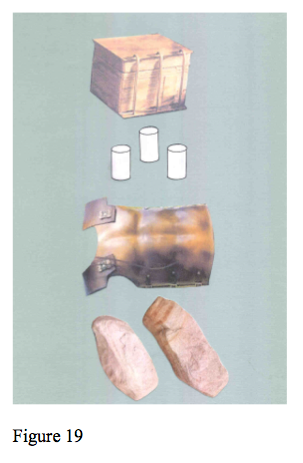
Keeping in mind that there are various versions of Joseph Smith’s first vision, the story of the stone box and its contents has more than one account. What is written in one record is similar, but not identical to the other, and gives additional information. It is difficult to reconstruct exactly how things were placed in the box, but a scenario may have looked something like this (see figure 19).
Elder Bruce R. McConkie described three major doctrines of the Church of Jesus Christ of Latter-day Saints, and they are what he called the “Three Pillars of Eternity.” They are 1. Creation, 2. The Fall, and 3. The Atonement. Perhaps that was the meaning that Moroni intended with the use of three pillars, or perhaps it was to symbolize the Godhead, or maybe they were placed for functionality to separate the plates from the breast-plate.
Whatever these three pillars stood for in the box that contained the golden plates of the Book of Mormon, we may not know until the Lord reveals that to us. But the use of three pillars topped by the Three Stones of Creation at Izapa, certainly causes one to think and ponder the possibilities.
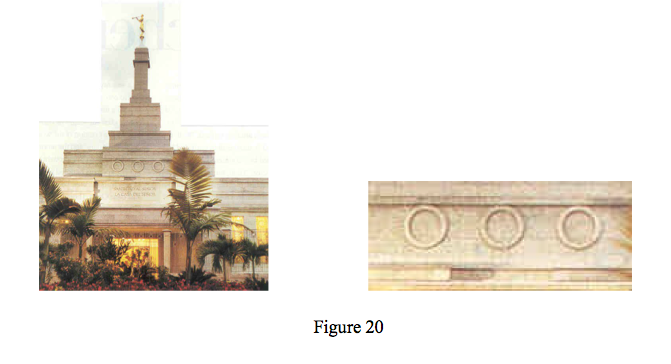
As Latter-day Saints the number three oftentimes represents the Godhead, and therefore the number three rivets our attention. Several LDS Temples have on their facades a grouping of three circles, for example, the Caracas Venezuela Temple (see Figure 20). A temple, whether ancient or modern, never incorporated a design without a symbolic meaning. It is a plausible assumption that these three circles represent the Father, Son, and Holy Ghost. A little food for thought―What do you think?
Notes:
1 John W. Welch, “Counting to Ten,” Journal of Book of Mormon Studies, Vol. 12, Is. 2 (Provo, UT: Maxwell Institute, 2003).
2 E. W. Bullinger, Number in Scripture: Its Supernatural Design and Spiritual Significance (Grand Rapids, MI: Kregel Pub., 1967), 107-108.
4 2 Ne. 11:3, 27:12, Ether 5:3-4, Moroni 6:7.
5 2 Ne. 25:13; Hel. 14:20, 27; 3 Ne. 8:3, 19, 23; 10:9.
6 3 Ne. 28: 4, 12, 36; 4 Ne. 1:14, 37.
8 See for example Ether 5:4.
9 Information supplied by John Tvedtnes, January 23, 2010.
10 Frank J. Lipp, The Mixe of Oaxaca: Religion, Ritual, and Healing (Austin: University of Texas, 1991), 20.
11 Karen Bassie Sweet, Maya Sacred Geography and the Creator Deities (Norman: University of Oklahoma Press, 2008), 177.
13 Ibid, 171, 177. Four Maize Gods symbolized the directions of the world. See Allen J. Christenson, Art and Society in a Highland Maya Community: The Altarpiece of Santiago Atitlan (Austin: University of Texas Press, 2001), 113. Four Bakabs also represent the directions of the world, which consequently makes the Bakabs an aspect of the Maize God (personal communication from Karen Bassie-Sweet, January 6, 2012).
14 Allen J. Christenson, Art and Society in a Highland Maya Community: The Altarpiece of Santiago Atitlan (Austin: University of Texas Press, 2001), 114-115.
16 David Stuart, The Inscriptions from Temple XIX at Palenque (San Francisco: The Pre-Columbian Art Research Institute, 2005), 183.
20 David Stuart, The Order of Days: The Maya World and the Truth about 2012 (New York: Harmony Books
21 III Hermas—Similitude IX:110, in The Lost Books of the Bible and the Forgotten Books of Eden (New York: The New American Library, Inc., 1974), 255.
22 David Stuart and George Stuart, Palenque: Eternal City of the Maya (London: Thames & Hudson, Ltd., 2008), 198.
24 Karen Bassie Sweet, Maya Sacred Geography, 177.
25 Possible title of Diane Wirth’s next book: Weaving Golden Threads of Gospel Truth.
26 David Stuart and George Stuart, Palenque, 170.
27 Archaeologists who research Mesoamerican gods often refer to their differing manifestations as convoluted, conflated or overlapping.
28 Gary A. David, The Orion Zone: Ancient Star Cities of the American Southwest (Kempton, IL: Adventures Unlimited Press, 2004).
29 See Diane E. Wirth, Parallels: Mesoamerican and Ancient Middle Easter Traditions (St. George, UT: Stonecliff Publishing, 2003).
30 The National Geographic, December 1995.
31 John Tvedtnes to Diane Wirth, January 23, 2012.
32 Linda Schele, Workbook for the XVIth Maya Hieroglyphic Workshop at Texas, March 14-15, 1992 (Austin: University of Texas), 130.
33 Annabeth Headrick, The Teotihuacan Trinity (Austin: University of Texas Press, 2007), 111.
34 David Stuart, The Inscriptions from Temple XIX, 162.
35 Howard Schwartz, Tree of Souls: The Mythology of Judaism (New York: Oxford University Press, 2004), 97.
36 Matthew G. Looper, To Be Like Gods: Dance in Ancient Maya Civilization (Austin: University of Texas, 2009), 116, 122.
37 Karl Taube, “The Jade Hearth: Centrality, Rulership, and the Classic Maya Temple,” in Function and Meaning in Classic Maya Architecture, Stephen D. Houston, Ed. (Washington, D.C.: Dumbarton Oaks Research Library and Collection, 1998), 461.
38 Robert F. Smith, “Assessing the Broad Impact of Jack Welch’s Discovery of Chiasmus in the Book of Mormon,” in Journal of Book of Mormon Studies, Vol. 16, Issue 2 (Provo, Utah: Maxwell Institute, BYU, 2007).
39 Karen Bassie-Sweet, Maya Sacred Geography, 113.
41 Robert F. Smith, Op. Cit.
42 Karl Taube, “The Jade Hearth,” 439.
43 Matthew G. Looper, Lightning Warrior: Maya Art and Kingship of Qurigua (Austin: University of Texas Press, 2003), 161; John Bierhorst, History and Mythology of the Aztecs: The Codex Chimalpopoca (Tucson: The University of Arizona Press, 1992), 23.
44 David Freidel and Barbara MacLeod, “Creation Redux: New Thoughts on Maya Cosmology from Epigraphy, Iconography, and Archaeology,” PARI Journal, Vol. I, No. 2, Fall 2000, 1-8, 18.
46 John Tvedtnes, personal communication, March 24, 1999.








.png)




 How far back in Mesoamerican mythology do the “Three Stones of Creation” exist in their creation lore? Several scholars believe the Olmec knew of the Three Stones of Creation as is evidenced in the Humboldt Celt, which was made about 500 B.C. (see Figure 14). The three stones are being cast by a hand, which would have been done by a creator god. Above it is a star eye and the three surrounding motifs are said to be clouds—so, this is an event that happened in the heavens.33
How far back in Mesoamerican mythology do the “Three Stones of Creation” exist in their creation lore? Several scholars believe the Olmec knew of the Three Stones of Creation as is evidenced in the Humboldt Celt, which was made about 500 B.C. (see Figure 14). The three stones are being cast by a hand, which would have been done by a creator god. Above it is a star eye and the three surrounding motifs are said to be clouds—so, this is an event that happened in the heavens.33


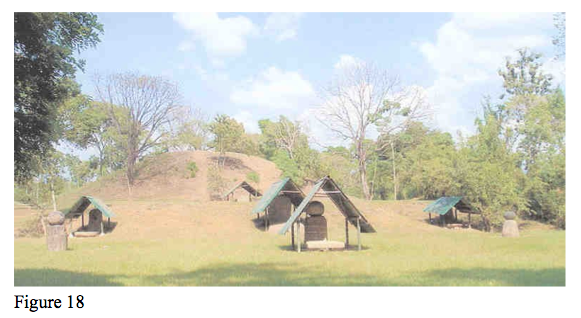 Probably the most impressive view of the “Three Stones of Creation” is dated to about 300 B.C. at Izapa, where large stones on top of three pillars that form a triangle represent the “Three Stones of Creation” (see Figure 18). Sitting on his throne with crossed-bands, which represented the axis mundi of the sky, the Izapa ruler was understood to be at the center of the cosmos when positioned directly in front of the triangle of the three raised hearthstones.42Stone spheres have been found all over the Maya area besides Izapa, but unfortunately many have been moved and are not in their original position.
Probably the most impressive view of the “Three Stones of Creation” is dated to about 300 B.C. at Izapa, where large stones on top of three pillars that form a triangle represent the “Three Stones of Creation” (see Figure 18). Sitting on his throne with crossed-bands, which represented the axis mundi of the sky, the Izapa ruler was understood to be at the center of the cosmos when positioned directly in front of the triangle of the three raised hearthstones.42Stone spheres have been found all over the Maya area besides Izapa, but unfortunately many have been moved and are not in their original position.



